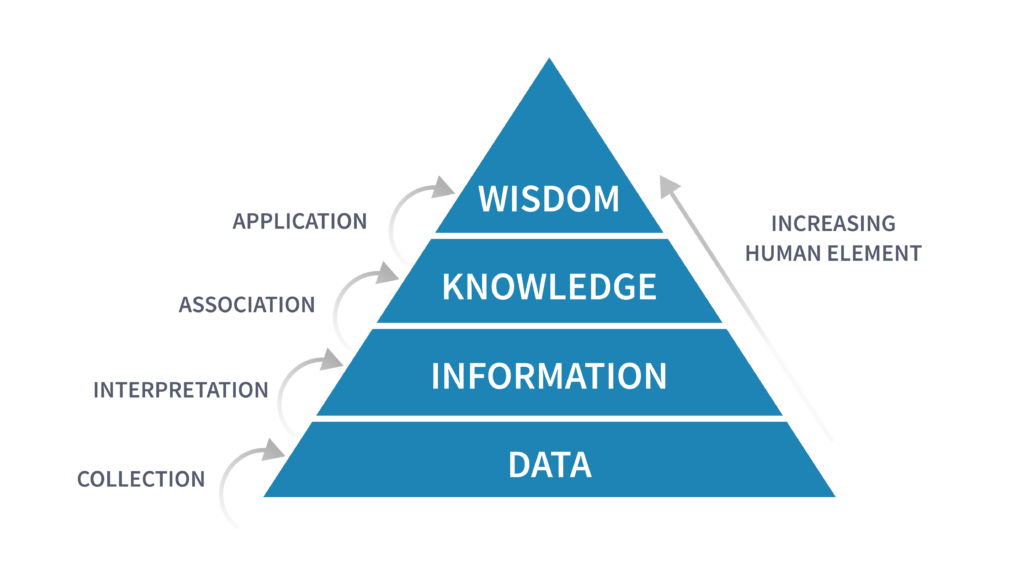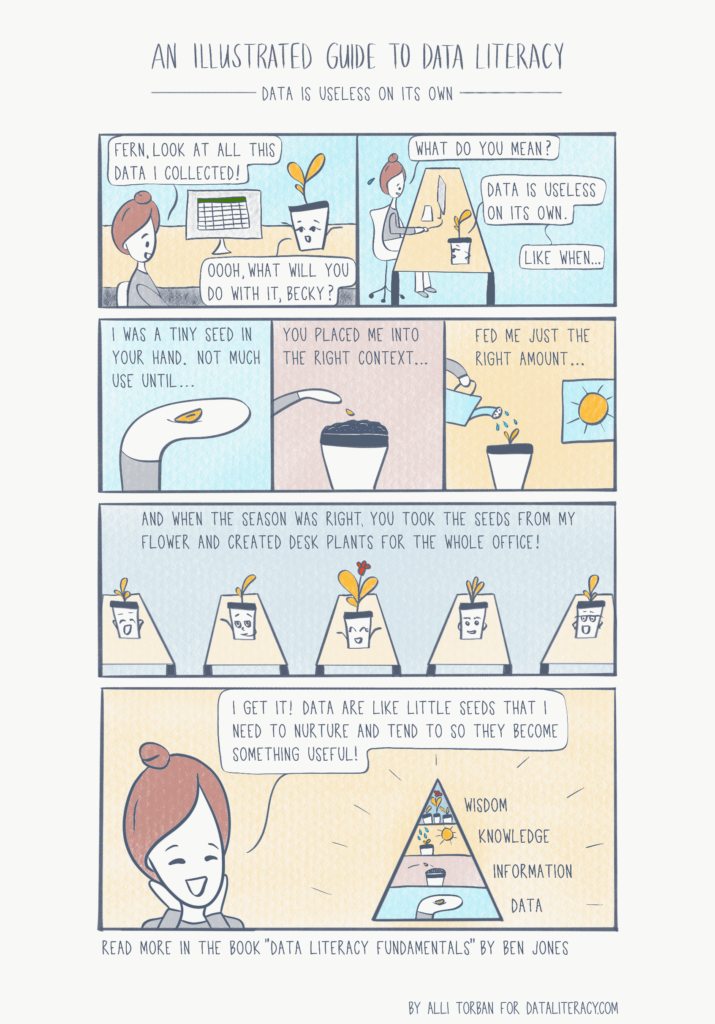The 1 Overall Goal of Data
Learning Objective: By the end of this lesson, you will be able to:
- Recall the correct form of the DIKW Pyramid.
- Match each of the four levels of the DIKW pyramid with its corresponding description.
- Evaluate different situations and recognize the associated level of the DIKW Pyramid.
- Apply your knowledge to construct a plan to move up to the next level of the DIKW pyramid.
The best decisions are data-informed rather than data-driven.
Let’s recap! What is the DIKW Pyramid?

The DIKW Pyramid is a model that represents the flow from raw data to wisdom, the one overall goal of data.
By applying the knowledge we form out of the information that our data provides we are able to make wise, data-informed decisions.
It’s important to note the increasing human element as you move further up the DIKW Pyramid. The further up you go, the more our goals, biases, priorities, values and ethics factor in.
Ascending the DIKW Pyramid
From Data to Information
In order to turn Data into Information, we need to first interpret any terms, acronyms, units, or conventions associated with the data. For example:
- EPS = “earnings per share”
- $ = U.S. dollars
- Q1 = the first quarter of the fiscal year
We also need to consider the structure of the data and how it might need to be restructured to suit our purposes. Methods of doing so include:
- Filtering: Choosing a subset of the data for view or analysis by excluding records you don’t want to view, and including those you do want to view.
- Example: We filtered the list of members to just those who joined the group in the last month, and we sent them a special welcome email.
- Aggregating: Collecting or gathering into a whole.
- Example: We aggregated all of the sales transactions for March to determine the total monthly revenue.
You can have data without information, but you cannot have information without data.
Daniel Keys Moran
From Information to Knowledge
Simply knowing one piece of information often leaves us wondering “So what?” You may have converted your checking account data into information about how much you spent on food last month, but until you compare this number with how much you spent on food in other months, or how much you spend on other things like rent or entertainment, then it’s not very actionable.
Here are some questions you can ask to help you ascend from the Information level to the Knowledge level of the DIKW pyramid:
- What is the context of the data?
- How was it collected, by whom, and for what purpose?
- With what is the information associated?
- What comparisons can we make to help us better grasp the relevance of the data?
Without context, a piece of information is just a dot. It floats in your brain with a lot of other dots and doesn’t mean a “…” thing. Knowledge is information-in-context – connecting the dots.
Michael Ventura in “Connecting a Few Dots” (February 28, 1997 article in the Austin Chronicle)
From Knowledge to Wisdom
Wisdom is “where the rubber hits the road” and all of our work with data culminates in better decisions and actions. Wisdom involves applying our knowledge to the making of right decisions. Since many situations are complex and involve competing priorities and conflicting data, the best decisions are data-informed rather than data-driven.
Lastly, wisdom involves even more of our humanity than the levels below it. Our goals and priorities factor in, as do important principles of values and ethics. Just because we use data, it doesn’t mean every decision will be obvious or straightforward. We should always consider the ethical implications of a decision and seek to avoid doing harm with data.
The wise do not confuse information or data, however prodigious or cleverly deployed, with comprehensive knowledge or transcendent wisdom.
Epictetus (as paraphrased by Sharon Lebell in The Art of Living)
Key Terms & Definitions
Hover over each card to flip it over and reveal its definition.
Data
Raw, unorganized facts (such as measurements or statistics) that need to be processed.
Information
Data that has been given context and meaning.
Knowledge
Information that has been processed by the human mind, understood, and associated.
Wisdom
Knowledge that has been deeply internalized and used for broader insights. It’s not just about having the knowledge, but also about understanding the broader implications and making decisions accordingly.
Filter
To choose a subset of the data for view or analysis by excluding records you don’t want to view, and including those you do want to view.
Aggregate
To collect or gather into a whole.
Data Ethics
The principles we adopt and measures we take in order to reduce the chance that we use data in a way that causes harm to others.
Knowledge Check 1
Below you’ll see four definitions. Identify which level of the DIKW Pyramid each definition corresponds to (Data, Information, Knowledge, Wisdom).
- Knowledge that has been deeply internalized and used for broader insights.
- Data that has been given context and meaning.
- Processed information that is understood and associated.
- Raw, unorganized facts that need to be processed.
Solution to Knowledge Check 1 (click to expand)
- Wisdom
- Information
- Knowledge
- Data
Knowledge Check 2
Evaluate the following examples. What level of the DIKW Pyramid does each example lie on?
- Carrying an umbrella due to predicted rain based on temperature fluctuations.
- A collection of numbers: 20, 45, 60, 85.
- Noting that book sales have been consistently good for a specific genre.
- Investing more in advertising a specific book genre based on consistent sales.
- Total book sales this week: 204.
- List of book sales: 50, 52, 49, 50
- Average temperature of a city over a week: Monday (20°C), Tuesday (45°C), etc.
- Understanding that temperature fluctuations indicate changing weather patterns.
Solution to Knowledge Check 2 (click to expand)
- Carrying an umbrella due to predicted rain based on temperature fluctuations. WISDOM
- A collection of numbers: 20, 45, 60, 85. DATA
- Noting that book sales have been consistently good for a specific genre. KNOWLEDGE.
- Investing more in advertising a specific book genre based on consistent sales. WISDOM.
- Total book sales this week: 204. INFORMATION.
- List of book sales: 50, 52, 49, 50. DATA
- Average temperature of a city over a week: Monday (20°C), Tuesday (45°C), etc. INFORMATION
- Understanding that temperature fluctuations indicate changing weather patterns. KNOWLEDGE
Knowledge Check 3
Read through the following scenario and then use your understanding of the DIKW Pyramid to answer three multiple-choice questions. Expand the accordion at the end for the solutions.
Scenario: Imagine you’re a newly appointed Data Analyst at GreenTech Innovations, a company focused on developing sustainable energy solutions. On your first day, the CEO hands you a thick folder labeled “2022 Energy Consumption Stats.” The folder contains numerous spreadsheets with rows and rows of raw data related to energy consumption metrics of the various products they have on the market. The CEO tells you, “We need to understand how our products performed last year, especially during the peak summer and winter months. Also, we want to make data-informed decisions for next year’s product lineup. Help us interpret, analyze, and leverage this data.”
Question 1 of 3
Given what you know about the DIKW pyramid, what is the first step you should take with the raw data provided?
- a. Compare the energy consumption stats of all the products to decide which ones to promote next year.
- b. Immediately propose adjustments to the products based on the numbers you see.
- c. Interpret terms, acronyms, units, or conventions associated with the data.
Question 2 of 3
After interpreting the data and turning it into meaningful information, you find out that one product consumed 15% more energy during the peak summer months compared to others. What would be the best approach to move up to the ‘knowledge’ level of the DIKW pyramid?
- a. Investigate the product’s summer suitability by examining data collection methods, influencing factors, and related data points.
- b. Immediately discontinue the product due to its higher energy consumption.
- c. Disregard this finding, as the performance of just one product may not be significant.
Question 3 of 3
As you analyze the data and start making recommendations, you realize that a product, which has higher energy consumption, is also the most affordable and popular among low-income communities. How do you apply ‘wisdom’ in this situation?
- a. Adjust pricing for consumption impact.
- b. Discontinue the product due to energy use.
- c. Consider ethics, community needs, and balance energy efficiency with affordability.
Solution to Knowledge Check 3 (click to expand)
Question 1: c
Question 2: a
Question 3: c
Resources for Further Learning
- Knowledge Management: A New Concern for Public Administration. Nicholas L. Henry
- Connecting a Few Dots. Feb 28, 1997 article in the Austin Chronicle by Michael Ventura.
- DataPractices.org – manifesto of 4 principles and 12 values of ethical data teamwork.
An Illustrated Guide to Data Literacy
An Illustrated Guide to Data Literacy is a comic series that explores a range of data literacy concepts. It follows Becky, who describes herself as a bit data-phobic, as she navigates tricky situations at work. She learns to create effective charts, grasp statistical concepts, and confidently clean data for analysis with the help of her faithful desk plant Fern. In this first comic strip, Becky discovers why she needs a plan for how she’ll use her data. Just collecting the data isn’t enough!
